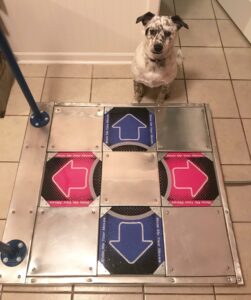Concept
For my finally project, I was inspired by a classic Japanese video game called “Dance Revolution.” In this game, the user hears a song and has to tap on the right tiles of the platform that is under them in order to win the game: the tiles on which the person has to tap on appear faster and the game becomes harder over time. However, to put my own spin on the project, I decided to reverse the idea, and create “Dance Evolution.” In this game, the user will not be given a prior song but rather a set of tiles that they have to press on, similar to the original, and construct the song themselves.

The tiles will be modeled after the iconic “Dance Revolution” tiles.
Implementation:
The user will construct the song with the help of a set of successive arrows that they have to tap on, which in turn represent a certain instrument. After tapping, these instruments will be layered and will start turning into an actual song. The trick is that the user has to tap on the arrows/tiles in a timely manner, as the time slot for a successful tap will shrink over time. The user wins if they are able to tap on all tiles correctly and create the song that consists of all instruments: the beat, the bass, the chords, the melody, the pad, etc. The user loses if they do not tap on the tile on time, thereby ruining the structure of the song.
The instruments will most likely be generated using p5.js, in order to add an element of randomness and unpredictability so that the melodies and the beats heard in one round of the game will be different in another round. The user will also have the possibility of changing the key of the song by using a distance sensor, allowing them to hear the song in different renditions of their own volition.
Arduino input:
There would be nine tiles in total and five of them would have a function. Each tile would be connected to a pressure sensor that would then trigger some sort of operation. The tiles on the sides pointing up, down, right, and left would be used for the game itself, while the tile in the middle would perform general functions such as restarting the game, going from one window to another.
Meanwhile, p5js would light up the tiles due to an LED connected to the tiles showing the user what tile to press on.

